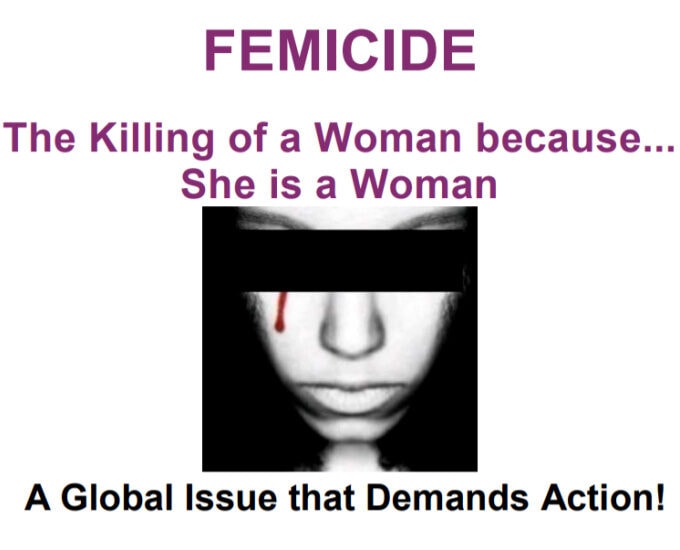
Symposium on Femicide held in
2012 at the Vienna International
Center, Austria.
Forever imprinted into Nova Scotians’ consciousness is profound shock and grief following the evil actions of a violent man’s mass femicidal and homicidal killings of April 18th and 19th. Reporting on his heinous acts the RCMP did not consider that misogynistic attitudes contributed to this violent man’s killing rampage. Nor obviously to his infliction of a “significant assault” on his female partner prior to his massive killings. When the police said they did not know the killer’s motive their statement failed to transparently reveal they had received in previous years complaints of the killer’s violent misogynistic acts of domestic assaults and his possession of guns.
Then Brenda Forbes appears and goes public. When interviewed by Carol Off in As It Happens, Brenda revealed how, in 2013, she had warned the RCMP that the killer was a violent and dangerous man. Describing to the RCMP how three male witnesses had watched the killer who had his female partner on the ground strangling her and screaming at her. In response, Brenda described that the RCMP asked her, “Can you get one of these guys to confirm what you just said?” When Brenda asked one male witness if he would confirm this, she said, he declined saying, “No way. …He’ll kill me.” Brenda also said she told the RCMP that the killer had guns, to which she says the RCMP said, “…we had to have, like, pictures or proof that he actually had these weapons….”
Brenda said she tried to alert other neighbours about this violent man’s dangerous actions. Most, she said, rejected her warnings.
Prior to Brenda going public, we had a telephone conversation with her. We are left with no explanation as to why Brenda’s reports were not taken seriously except that attitudes of misogyny within the RCMP devalued the dangers embedded in domestically violent relationships. We have ample reason to think this given that RCMP Deputy Commissioner Kevin Brosseau stated there is a culture of misogyny within the RCMP.
Other Nova Scotian women relate to Brenda’s experiences. Wanting to add support to Brenda’s courage to speak out, women wanted to share bits of their own experiences. With the hope that Nova Scotians will deep dig into doing what must be done to transform who we are, the culture we choose to shape and live in, and how we will give meaning to caring about each other. Such truth-examinations can be–are painful. Just as Brenda expressed her pain when recalling her experiences, so too do the following women.
Jolene: Thinking back to 2013
Looking backwards, I wish I knew now what I do and I had the strength that I have today. When I bought my house in Bible Hill 7 years ago there was a gal across the street who had serious issues with narcotics. I was scared of her. One day she was attacked in her yard by a man in a red car, a weird 2 door jobbie with the strange lines down the back window that were popular in the 1980s. He was hitting her over and over. I locked my son in the house and went to the end of my driveway screaming at him to stop. He eventually drove away.
I called 911. I waited to report to the RCMP. The officer who I tried to give my report to, a…tall man…, told me unless I could promise on the spot I had never broken the law my word was no good to him. As a single mom, as a trauma survivor from a family of misfits, it was a promise I couldn’t make and a risk that terrified me. I wonder how many others have faced his response?
Not long after, I attended my neighbour’s funeral caused by an overdose. I don’t want to interject myself or my experiences…except they validate Ms. Forbes’ experience. I just had to say it out loud.
Stacey: Strangled once
With the increase in discussions around domestic violence, misogyny…and femicide…since the mass shootings…brought back in time over and over again in my mind….[t]he first time he hit me was ten days after we were married,…I had a can of Pepsi, and after a drink, I burped. He leapt up, and stormed over and started slapping me. Hard. I tasted blood. He called me disgusting, demanding to know why I would do something so disgusting. Was I an animal? I was in a corner, on the floor, he was looming over me, I kept apologizing. Then I said nothing.
I was in my early 20s the first and only time he strangled me, spitting and yelling at me….don’t ever tell me I do not know what I am talking about when it comes to violence against women. [People] would never guess that I was a woman who stayed after being hit, many times over….No one generally ever really asks or pushes for details.
Lenore: Also strangled once
Some experiences I have never shared before include when in a relationship with a male partner there were weeks of cold shoulder silent treatment and other days when he would explode. I remember the day he grabbed me by my neck and pushed me off the kitchen stool shoving my head into the dish of cat food that was on the floor. With his hands around my throat he was screaming at me, white froth coming out of his mouth. I remember going limp. I’ve blocked out what he was shouting at me.
Whenever I was yelled at, called names, and put down I thought it was my fault. I was confused because his behaviour was sporadic—sometimes he was nice then not so nice. It was only after I went to therapy that it was explained to me that his behaviour was abuse. I didn’t know what abuse was until then.
Listening to other women’s telling means we must also truth-tell as women who grew up in family violence. We too must admit being pulled back into memories of violence. For me Linda, I’m pushed back into the 50s and 60s and the bystanders not believing me when I tried to tell that my father was violent. He had a gun which he pointed at my mother’s head. Eventually I gave up telling. I learned it was useless to talk about my father’s violence because people looked at me as if I was the crazy one.
The description of “Lisa” hiding in the woods after escaping the killer’s violence attack ignites, for instance, my memories. It tosses me, Jeanne, back to recalling how as a young child I would watch my mother’s eyes and her body language that told me she was getting ready to find the exact moment when she, my brother, and I could safely escape our ‘home’ to hide in the woods. Once in the woods our silence was automatic. The passage of time disappeared. The only focus was deciding when it was safe to re-emerge from our woodland hiding place. It is this memory that gives me ‘privileged’ insight into imaging how “Lisa” may have endured her terrifying hours of her hiding ordeal. And that of the young man whose brother was murdered, who also sought the safety of hiding in the woods.
Plenty of Warning Signs
Research into mass shootings within Canada reveals a connection between men’s misogynistic-based violence against women, including committing many forms of assaults, torture, and femicides, including committing crimes against others. The Nova Scotia mass shootings are no exception. The misogynistic culture of the RCMP must be considered as influencing the dismissal of Brenda Forbes’ reports. Does the RCMP have a checklist that requires them to ask questions to correctly assess the dangers women, children, and others in a community face? Or, does a misogynistic culture toss aside attending to the warning signs indicative of pending and rising danger such as:
- Acknowledging that when a violent man has access to guns the risks of femicide increases. Femicidal killing of women and girls by violent predominately white men involves different relational issues than men killing other men. Femicidal killings are marred by domestic violence with attitudes of gaining, possessing, and exerting power and control over his female partner’s life. Guns are also weapons used to inflict domestic terrorism and to rape with.
- Brenda had told the RCMP about the killer’s violent anger, and his controlling, and stalking behaviours. A history of anger is action displayed by mass killers.
- Canadian data says that violence within relationships increases significantly from late Friday night to Sunday. This violent man began killing late Saturday night. The RCMP did not appear to ask Brenda whether the killer’s pattern of violent acts escalated on week-ends.
- Brenda told the RCMP that the killer’s partner had been strangled. A non-fatal strangulation—meaning the woman does not die—is a warning sign of a future femicide. Non-fatal strangulation is a serious warning sign when inflicted by a violent man against an intimate partner. Over the past four years about half of all individuals who seek support at the Ontario Windsor Regional Hospital’s sexual assault and domestic violence centre report being strangled. When strangulation is a violent repetitive pattern research says the risks of femicide increases 750 percent.
Worldwide research presently states that 35 percent of the women and girls on this planet will experience acts of physical and or sexualized violence committed by their partner or suffer non-partner sexualized violence in their lifetime. Further research says it is their male partner or another male family member who will predominately kill them. Assaults, torture, femicides, and other violent crimes perpetrated within relationships are Nova Scotian realities. Just as written in the 1910 book in our possession that describes how one-third of the 100 girls trafficked out of Atlantic Canada into the U.S. were from Nova Scotia. All Nova Scotians have the capability to re-design our relational futures.
A provincial inquiry with a feminist lens focused on confronting the degrees of men’s violence including femicides inflicted against women is essential. An inquiry must stay local—be voiced locally—to extend healing support and provide a local say in re-designing a non-violent culture for our future.
See also: Pandemics: Misogynistic violence against women and girls and COVID-19
Are you facing intimate partner violence? Here are some Nova Scotia resources that can help, as compiled by the CBC

Jeanne Sarson, MEd, BScN and
Linda MacDonald, MEd, BN
Co-founders Persons Against Non-State Torture (NST)
Human Rights Defenders
361 Prince Street, Truro, NS, Canada B2N 1E4
P: 1.902.895.6659 | C: 1.902.956.2117 | twin2@eastlink.ca
www.nonstatetorture.org
contact@nonstatetorture.org
With a special thanks to our generous donors who make publication of the Nova Scotia Advocate possible.
Subscribe to the Nova Scotia Advocate weekly digest and never miss an article again. It’s free!



